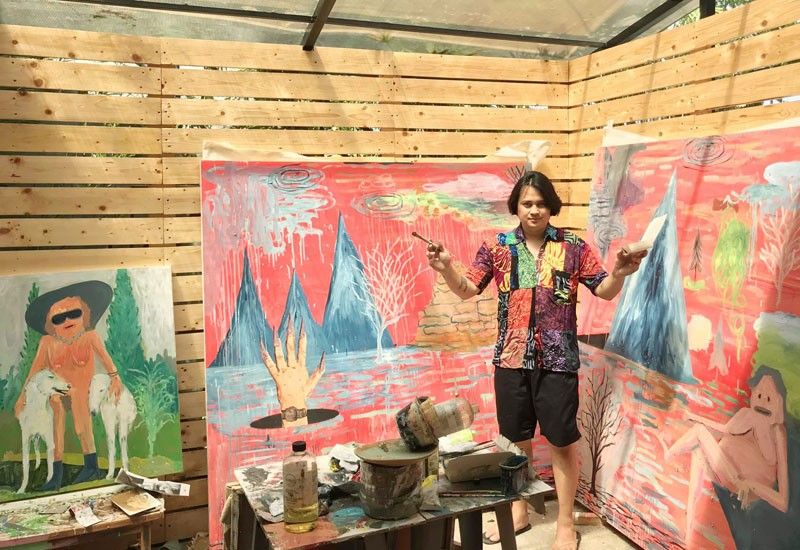Art, a quick look through the browser


We can spend hours enumerating what actual experiences have to offer that virtual ones can’t substitute. Take online exhibitions. Suppose we see them as proxies, temporary stand-ins we try to enjoy until the real ones return; then we end up fixating on what gets lost in translation.
Mark Salvatus, co-founder of the platform Load na Dito, reminds us that online projects have been around for some time. “(They were) called net art in the late ’90s and early 2000s,” says Salvatus. “This is very different from transplanting a physical exhibition to online since the works themselves were made within the virtual space for online viewing. The production and presentation is at the same stream, the same time and space.”
Perhaps art online, as this piece of history tells us, is promising not for how it simulates physical exhibitions but how it enables experiences and ways of doing what actual shows can’t provide. In-between hard lockdown and now — when artists and handlers are easing back into the grind of hanging their works — some Manila-based spaces have launched exhibitions that are exclusively online, playing with formats ranging from no-frills web pages to a virtual staging inspired by video games.

Important for Silverlens and Artinformal galleries was keeping their artists connected with their audience. At the beginning of the month, Silverlens launched “Anticipating the Day” which saw the works sitting, lying, hanging in the artists’ studios. “We found ourselves trying to replace that elemental experience less and relying more on the backend of all shows — the artists and their studios,” says gallerist Rachel Rillo. We see for instance Corinne de San Jose at work and Pow Martinez holding up a brush with his paintings behind him, presumably still wet. The two artists launched their respective solo exhibitions last June 25. Gallerist Isa Lorenzo reveals that in the coming months, while the onsite shows will be anchors, there will be more variety with Silverlens’ online presentations.
Artinformal, after their online-only exhibit “Becoming Trees,” is set to stage both an onsite-exhibition and another online group show this July. In the middle of uncertain, anxious times, the gallery opted for a clean, straightforward webpage gathering together the works and statements of artists stuck in lockdown. “What was important was to keep the viewer engaged and not troubled with the complications of navigating a new software,” says gallerist Tina Fernandez.
The challenge with exhibition-making now is how to mitigate risks and at the same time how to introduce them. When going out is itself already a hurdle, the first question curator Dayang Yraola had to answer was whether her exhibition “should still happen or not.” Yraola is Fundacion Sansó’s first Curatorial Grant recipient. On June 1, she launched the online show “Mutation Series,” which was originally conceived as a gallery exhibit. The first new, unfamiliar thing we are confronted with is space. “I borrowed inspiration from the games my nephew and niece were playing,” explains Yraola, “I wanted something like Minecraft-ish staging.” Yraola worked closely with her sister Millet Yulo, who practices as a graphic designer and architect, and helms the design-and-build architecture firm AdForm. They constructed an exhibit site — running until June of next year—which lets us wander around a virtual space of Fundacion Sansó, zoom in and out, and experience the sound pieces of Children of Cathode Ray and Rubber Inc, and the moving images of Annie Pacan?a.
While there was much work that went into the crafting of space alone, Yraola explains that her creative process as a curator still begins with the artworks themselves. “How it will be perceived should come from what the materials require... As a curator, the commitment to uphold the integrity of the materials, which is both the artwork I am exhibiting and its staging ground, is something that I try to constantly adhere to.” With paintings, there is a focus demanded by the medium that the audience cannot give when viewing them on a screen. Opening several browsers and fidgeting with apps, she notes, “is a decorum, a habit and a culture.” So Yraola designed an exhibition that audiences can experience while “doing something else.” Perhaps it isn’t so different from how we experience music.

Online exhibitions may not be new, but this insistence on producing and presenting works online may also be driven by new needs and new anxieties. Elsewhere in this arts ecology, auction results are keeping up an appearance of a robust market, while tending to obscure the wobbly economic grounds that artists tread. How much risk are galleries and museums willing to take, not just in terms of platform or design, but also in the artists they support and exhibit?
Salvatus, who started Load na Dito with Mayumi Hirano in 2016 to generate various formats of connectivity using art, insists that “in this time of social distancing, we need to be more collective to support each other in any way we can.” Online space for him created meaningful and critical connections among artists when physical spaces were pushed to close shop. When I worry about the sustainability of constant online production during a pandemic — for labor may mean not just care for work and artist, but also care for staff — Load na Dito’s first curated project comes to mind. In May last year, they staged “Kabit at Sabit,” which invited artists to hang works across multiple venues for one day, inspired by the communal tradition of Pahiyas when houses are bedecked with bric-a-brac. “It played with multiple layers of viewing experience,” says Salvatus, “both physical and virtual, online and offline.” It straddled distance and dispersal with connectedness and communality.
When exhibition-making must be attentive to material, audience, concept and space, how do we make the most of online platforms to enable a system of care for artists? How do we create art online, knowing that the product isn’t only the work but the sustained forms of exchanges — the sense of community — that the work generates? So much to do and finally we have time.



















